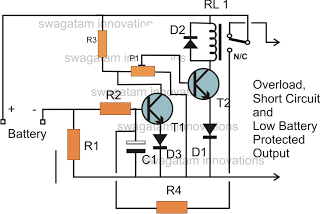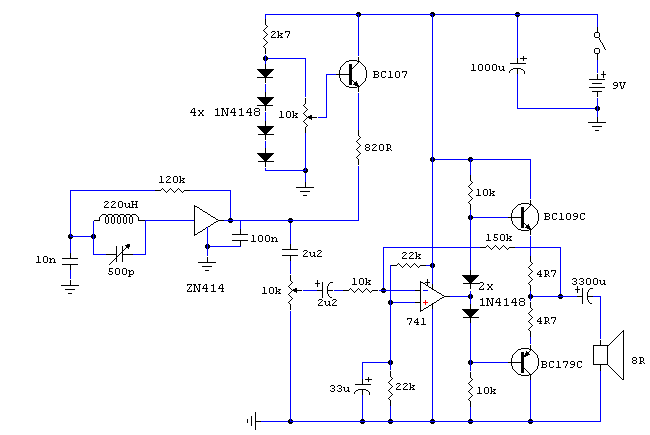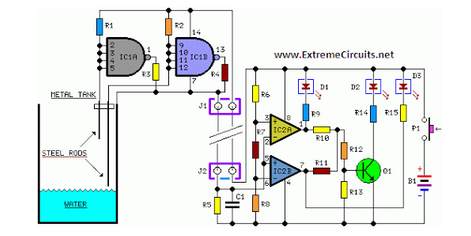
Electronic Head or Tail Circuit

The principle utilized in this electronic head or tail circuit is straightforward: a multivibrator controls a flip-flop. The multivibrator oscillates as long as the button S1 is pressed, while the flip-flop toggles on and off at a frequency of several kilohertz. Upon releasing the button, a +5 volts signal is applied to one of the two gates that comprise the multivibrator. The flip-flop latches into one of two possible states: head or tail. The specific state of the flip-flop is determined by the precise moment the button S1 is released. Due to the speed of the flip-flop's switching and the inherent delay in human reaction time, the state at which the flip-flop latches is random. The entire circuit is constructed using a single 7400 IC. It is crucial to decouple the circuit and the display bulbs effectively to prevent reverse voltages and currents that may arise during the switching off of the display bulbs.
The described electronic head or tail circuit employs a multivibrator and a flip-flop, which are fundamental components in digital electronics. The multivibrator serves as an oscillator that generates a square wave output when the button S1 is pressed. This oscillation continues as long as the button remains engaged, producing a frequency in the kilohertz range. The output from the multivibrator is fed into the flip-flop, which is configured to toggle between its two stable states based on the input signal.
When the button is released, the multivibrator ceases oscillation, and a +5 volts signal is applied to one of the flip-flop's inputs. This input signal is critical as it determines the state of the flip-flop at the moment of button release. The randomness of the output (head or tail) is influenced by two factors: the inherent switching speed of the flip-flop and the reaction time of the user. This design introduces an element of chance, making the circuit suitable for applications requiring randomization.
The use of a single 7400 IC simplifies the design, as this quad two-input NAND gate IC can be configured to create both the multivibrator and the flip-flop functionalities. Careful attention should be given to the decoupling of the circuit to ensure reliable operation. This involves using capacitors to filter out noise and prevent voltage spikes that may occur when the display bulbs are turned off. Proper decoupling is essential to maintain the integrity of the circuit and prevent unintended behavior due to transient voltages.
In summary, this electronic head or tail circuit is a practical example of using basic digital components to create a randomizing mechanism, demonstrating key principles of multivibrator and flip-flop operation while emphasizing the importance of circuit design considerations such as decoupling.The principle used in this electronic head or tail circuit is simple: a multivibrator controls a flip flop. The multivibrator oscillates as long as the buton S1 is pressed and the flip flop switches on and off with a frequency of several kilohertz.
When the button is released, a +5 volts is set at one of the two gates that makes up th multivibrato r. The flip flop latches on at one of the two possible states: head or tail . The state of the flip flop is dependent on the exact time when the button S1 was released. because the speed of the flip flop`s switch overs and the relative inertia of the human reaction, the state at which the flip flop latch is random. The entire circuit is made up of a single 7400 IC. It is important to decouple the circuit and the display bulbs very well to avoid reverse voltages and currents that appear during the switching off of the display bulbs.
🔗 External reference
The described electronic head or tail circuit employs a multivibrator and a flip-flop, which are fundamental components in digital electronics. The multivibrator serves as an oscillator that generates a square wave output when the button S1 is pressed. This oscillation continues as long as the button remains engaged, producing a frequency in the kilohertz range. The output from the multivibrator is fed into the flip-flop, which is configured to toggle between its two stable states based on the input signal.
When the button is released, the multivibrator ceases oscillation, and a +5 volts signal is applied to one of the flip-flop's inputs. This input signal is critical as it determines the state of the flip-flop at the moment of button release. The randomness of the output (head or tail) is influenced by two factors: the inherent switching speed of the flip-flop and the reaction time of the user. This design introduces an element of chance, making the circuit suitable for applications requiring randomization.
The use of a single 7400 IC simplifies the design, as this quad two-input NAND gate IC can be configured to create both the multivibrator and the flip-flop functionalities. Careful attention should be given to the decoupling of the circuit to ensure reliable operation. This involves using capacitors to filter out noise and prevent voltage spikes that may occur when the display bulbs are turned off. Proper decoupling is essential to maintain the integrity of the circuit and prevent unintended behavior due to transient voltages.
In summary, this electronic head or tail circuit is a practical example of using basic digital components to create a randomizing mechanism, demonstrating key principles of multivibrator and flip-flop operation while emphasizing the importance of circuit design considerations such as decoupling.The principle used in this electronic head or tail circuit is simple: a multivibrator controls a flip flop. The multivibrator oscillates as long as the buton S1 is pressed and the flip flop switches on and off with a frequency of several kilohertz.
When the button is released, a +5 volts is set at one of the two gates that makes up th multivibrato r. The flip flop latches on at one of the two possible states: head or tail . The state of the flip flop is dependent on the exact time when the button S1 was released. because the speed of the flip flop`s switch overs and the relative inertia of the human reaction, the state at which the flip flop latch is random. The entire circuit is made up of a single 7400 IC. It is important to decouple the circuit and the display bulbs very well to avoid reverse voltages and currents that appear during the switching off of the display bulbs.
🔗 External reference
Warning: include(partials/cookie-banner.php): Failed to open stream: Permission denied in /var/www/html/nextgr/view-circuit.php on line 713
Warning: include(): Failed opening 'partials/cookie-banner.php' for inclusion (include_path='.:/usr/share/php') in /var/www/html/nextgr/view-circuit.php on line 713





